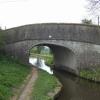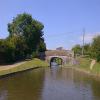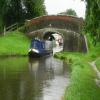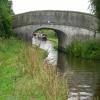
There is a bridge here which takes a minor road over the canal.
| Deans Hall Bridge No 12 | 1 mile, ½ furlongs | |
| School Bridge No 13 | 6½ furlongs | |
| Brewood Bridge Visitor Moorings | 5¼ furlongs | |
| High Green Bridge No 14 | 5 furlongs | |
| Brewood Wharf | 3 furlongs | |
| Skew Bridge No 15 | ||
| Broomhall Bridge No 16 | 1 furlong | |
| Belvide Reservoir Feeder | 3 furlongs | |
| Stretton Aqueduct | 5 furlongs | |
| Stretton Boatyard | 5½ furlongs | |
| Lapley Wood Bridge No 17 | 1 mile, 4¾ furlongs | |
Amenities nearby at Brewood Wharf
Why not log in and add some (select "External websites" from the menu (sometimes this is under "Edit"))?
Mouseover for more information or show routes to facility
Nearest water point
In the direction of Autherley Junction
In the direction of Nantwich Basin Entrance
Nearest rubbish disposal
In the direction of Autherley Junction
In the direction of Nantwich Basin Entrance
Nearest chemical toilet disposal
In the direction of Autherley Junction
In the direction of Nantwich Basin Entrance
Nearest place to turn
In the direction of Autherley Junction
In the direction of Nantwich Basin Entrance
Nearest self-operated pump-out
In the direction of Autherley Junction
In the direction of Nantwich Basin Entrance
Nearest boatyard pump-out
In the direction of Autherley Junction
In the direction of Nantwich Basin Entrance
Wikipedia has a page about Skew Bridge
A skew arch (also known as an oblique arch) is a method of construction that enables an arch bridge to span an obstacle at some angle other than a right angle. This results in the faces of the arch not being perpendicular to its abutments and its plan view being a parallelogram, rather than the rectangle that is the plan view of a regular, or "square" arch.
In the case of a masonry skew arch, the construction requires precise stonecutting, as the cuts do not form right angles, but once the principles were fully understood in the early 19th century, it became considerably easier and cheaper to build a skew arch of brick.
The problem of building skew arch masonry bridges was addressed by a number of early civil engineers and mathematicians, including Giovanni Barbara (1726), William Chapman (1787), Benjamin Outram (1798), Peter Nicholson (1828), George Stephenson (1830), Edward Sang (1835), Charles Fox (1836), George W. Buck (1839) and William Froude (c. 1844).


































